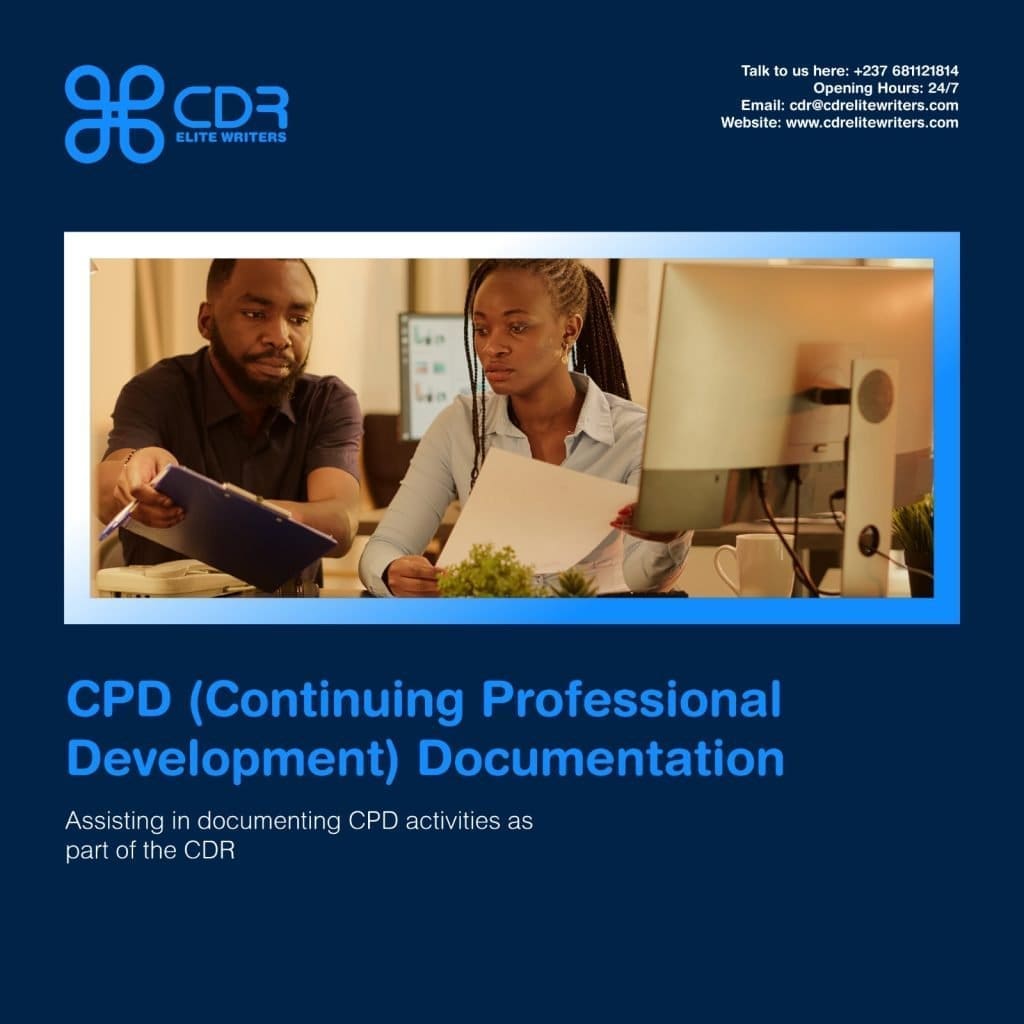Introduction
Continuing Professional Development, or CPD, is a foundational component in the field of engineering, critical for maintaining competency and staying abreast with the ever-evolving industry standards, technology, and practices. In the context of an Engineers Australia (EA) Competency Demonstration Report (CDR Report), showcasing a consistent commitment to CPD allows engineers to demonstrate their dedication to professional growth and their proactive approach to learning.
This commitment is vital for the recognition as a deemed professional engineer, as it reflects an individual’s ability to adapt to change, pursue excellence, and make meaningful contributions to their field. Thus, embedding an in-depth CPD record within an Engineers Australia CDR report is not only a requirement but also a strategic move that highlights an engineer’s long-term investment in their professional capabilities.
As we delve into the main focus of this document, it’s important to understand that a well-documented CPD record is more than just a checklist for Engineers Australia’s assessment—it’s a narrative of your professional journey. In the following sections, we’ll explore the various forms of CPD activities that are recognized by Engineers Australia, as well as how to effectively document and reflect upon these experiences. This will not only prepare you for a successful CDR Report submission but will also aid in cementing a culture of ongoing personal and professional development that is at the heart of engineering excellence.

Table of Contents
what does continuing professional development mean
Continuing Professional Development (CPD) can be defined as the systematic maintenance, improvement, and broadening of knowledge and skills, as well as the development of personal qualities necessary for the execution of professional and technical duties throughout an engineer’s career. CPD is a commitment to being professional, keeping up to date, and continuously seeking to improve. It is the key to optimizing a career in a field as dynamic as engineering, where technological advancements and innovative methods revolutionize the landscape at a rapid pace.
In the domain of professional engineering, Continuing Professional Development plays a pivotal role in both personal and sector-wide progression. It ensures that professionals are not merely keeping pace with the industry’s advancements but are also contributing to its evolution. CPD encourages a lifelong learning mindset, indispensably linking theoretical knowledge to practical skills. By diversifying their expertise through various activities, engineers can anticipate global trends, innovate, and adapt their approaches to complex challenges.
Requirements for CPD Activities in CDR Report
Engineers Australia mandates a structured approach to CPD, necessitating a minimum of 150 hours of related activities over three years. This equates to an average of 50 hours per year, though there is flexibility in how these hours are accumulated to allow for periods of more or less intensive learning. The type of activities that qualify for CPD include formal post-graduate education, attending industry-related conferences, workshops, seminars, and even private study of relevant literature, standards, and regulations.
Ultimately, these CPD requirements are reflective of Engineers Australia’s dedication to high standards and continuous improvement within the field. By fulfilling these requirements, engineers affirm their ongoing commitment to excellence and their readiness to meet the future challenges of the engineering profession.
Types of CPD Activities Considered
Engineers Australia recognizes a wide spectrum of activities as part of Continuing Professional Development (CPD) to accommodate various learning styles and opportunities available in the engineering sector. The following are regarded as acceptable CPD activities:
- Formal Education: Enrolling in postgraduate studies, such as master’s or doctorate degrees, that are specifically tailored to the field of engineering can provide valuable expertise and advanced knowledge. Additionally, pursuing technical training or certification courses can further enhance your skills and make you stand out in the competitive job market. These educational opportunities not only deepen your understanding of engineering principles but also equip you with the necessary tools and qualifications to succeed in your career.
- Workshops, Seminars, and Conferences: Active participation in events that are technical or professionally relevant is highly beneficial, as they offer abundant opportunities for learning, skill development, and valuable networking connections. Attending such events allows individuals to stay up-to-date with the latest trends, gain insights from industry experts, and forge meaningful relationships with like-minded professionals.
According to a survey conducted by Engineering.com, 92% of employers consider participation in engineering workshops as a valuable asset when evaluating job applicants
- Professional Practice: A substantial proportion of Continuing Professional Development can be gained through the experience gained in the practice of engineering. According to Engineers Australia, actively working in an engineering role contributes to CPD through the practical application of skills and
- Private Studies: This incorporates self-directed learning endeavors such as reading books, journals, or industry publications that provide valuable insights, knowledge, and up-to-date information on current trends, emerging technologies, and innovative practices in the field of engineering. By engaging in these activities, individuals can continuously expand their understanding, stay abreast of the latest advancements, and enhance their professional expertise.
- Publications and Presentations: Contributing scholarly articles to reputable professional publications or presenting well-researched papers at esteemed conferences are highly regarded as valuable Continuing Professional Development activities. These activities not only showcase the synthesis and dissemination of professional knowledge but also highlight the dedication and expertise of the individuals involved. By engaging in such activities, professionals actively contribute to the advancement of their respective fields, fostering collaboration and encouraging further exploration of new ideas and insights.
- Volunteering: Engaging in voluntary work for engineering societies, boards, or committees can be highly beneficial. This involvement not only offers opportunities to take on roles of responsibility but also allows individuals to gain new competencies and expand their skill set. By actively participating in such activities, individuals can contribute to their professional community while also enhancing their own personal and professional growth.
- Mentoring: Whether you take on the role of a mentor or a mentee, both positions offer distinct opportunities for professional growth and valuable knowledge exchange. As a mentor, you can share your expertise and guide others on their career paths, while as a mentee, you can benefit from the guidance and wisdom of more experienced individuals. Engaging in mentoring relationships can foster meaningful connections, expand networks, and enhance skills, ultimately contributing to personal and professional development.
By involving themselves in these activities, engineers are able to maintain a record of CPD that reflects a commitment to lifelong learning and continual improvement of their professional skills and knowledge.

Writing CPD for Your CDR Report
When documenting your Continuing Professional Development, it is crucial to do so clearly and effectively to illustrate your commitment to professional development. Here are some tips to keep in mind:
- Be Specific: Ensure each CPD activity includes detailed information such as the title of the course or event, the date it was undertaken, the provider’s name, and the duration. Specific details provide credibility to your record.
- Reflect on Learning Outcomes: For each activity, briefly describe what you learned and how it applies to your engineering career. Reflection on outcomes shows active engagement and critical assessment of the CPD’s value to your professional growth.
- Follow the CPD Requirement Guidelines: Adhere to the CPD requirement guidelines to ensure compliance. This will help in maintaining a logbook to systematically record all activities, preventing last-minute rushes and ensuring completeness and accuracy.
- Provide Evidence: Where possible, include evidence such as certificates, attendance records, or completed assignments to support your Continuing Professional Development claims. This documentation can be especially useful in the case of an audit.
- Highlight Relevance: Align activities with your career goals and the competencies required by Engineers Australia. This demonstrates an intentional approach to Continuing Professional Development and its impact on your professional trajectory.
- Stay Current: Prioritize recent activities that show you are up-to-date with the latest engineering trends and practices, as this highlights your current expertise to assessors.
By adhering to these tips, you will compile Continuing Professional Development documentation for your CDR Report that is comprehensive, organized, and reflective of your ongoing dedication to professional excellence.
Linking CPD Activities to Core Competencies
When aligning Continuing Professional Development activities to core competencies, it’s essential to make a succinct yet direct correlation between the knowledge gained and the skills required by Engineers Australia. Here’s how you can make these connections clear within your CDR Report:
- Identify Core Competencies: It is important to thoroughly review the core competencies required by Engineers Australia. Take the time to understand the key areas in which you need to demonstrate proficiency. This will provide you with a clear understanding of the skills and knowledge that are expected of you. By doing so, you will be better prepared to meet the requirements and excel in your engineering career.
- Map the Connection: For each activity, outline how it specifically enhances one or more core competencies. Demonstrate the direct application of what you’ve learned to your engineering practices. By highlighting the correlation between activities and core competencies, you can showcase your commitment to continuous professional growth. This proactive approach not only strengthens your skills but also positions you as a valuable asset in the engineering field. Embrace the opportunity to expand your knowledge and contribute to the advancement of your profession.
- Provide Examples: Use concrete examples from your activities to show how they have contributed to your skill development. This can include projects you’ve worked on, challenges you’ve overcome, or new techniques you’ve mastered as a result of your learning. These examples not only demonstrate your growth but also highlight the practical application of your acquired knowledge.
- Use Reflective Writing: Engage in reflective writing that assesses the impact of CPD activities on your professional capabilities. Reflect on how these experiences have shaped your approach to engineering problems and tasks. Consider the lessons learned and how they can be applied in future endeavors. Embrace the growth and development that comes from continuous professional learning.
- Quantify Improvements: Where possible, quantify the improvements or results achieved through applying the knowledge from activities. This could be in terms of efficiency gains, cost savings, or successful project outcomes. Additionally, measuring the impact of CPD helps in identifying areas for further growth and development.
Remember, the goal is to create a compelling narrative in your CDR Report that connects your CPD efforts directly to the core competencies, demonstrating your growth and capacity as an engineering professional.
Conclusion
In summary, CPD is a vital aspect of an engineer’s career advancement and professional proficiency, as recognized by Engineers Australia. Activities range from formal education to private studies, all contributing to an engineer’s knowledge and skills. Key practices for effective CPD documentation include being specific, reflecting on learning outcomes, using a logbook, providing evidence, highlighting the relevance of activities, and staying current with industry trends.
Continued learning and professional development should not be seen merely as a requirement, but as an enriching journey that assures you remain at the forefront of engineering innovation and best practices. In a field where technology and methodologies evolve rapidly, your professional development is a testament to your dedication and passion for excellence.
Need Help?
If you require personalized guidance or assistance in crafting your Continuing Professional Development (CPD) to the highest standards, do not hesitate to contact our team at CDR Elite Writers. We specialize in providing professional support to ensure your CDR Report shines with excellence and meets the Australian engineering competencies criteria. Get in touch today for expert help!




